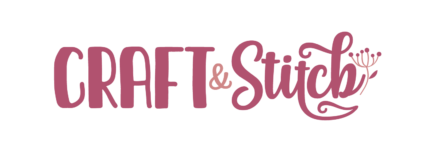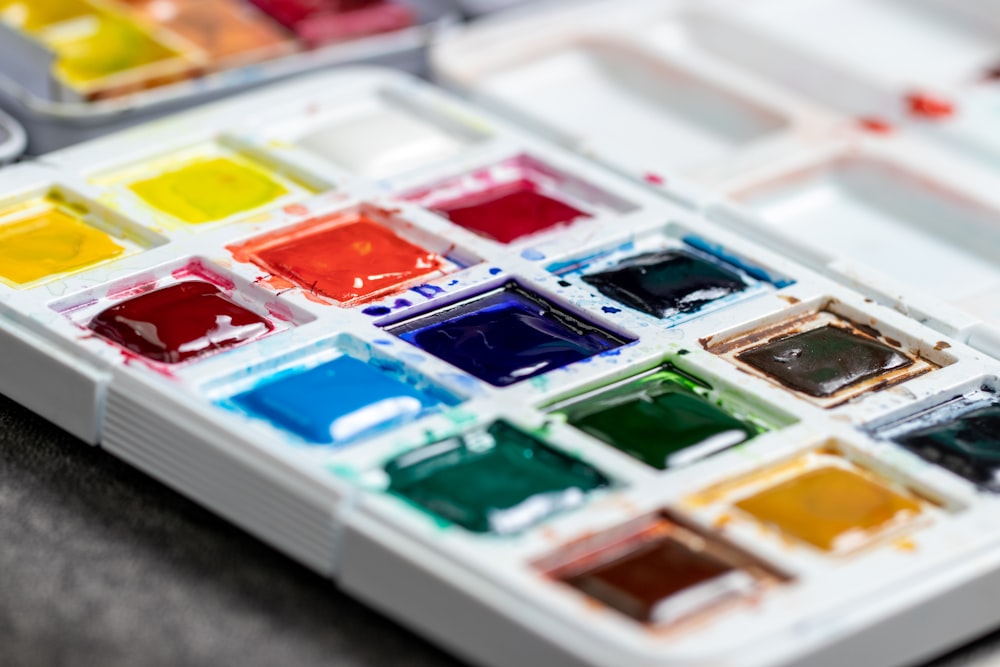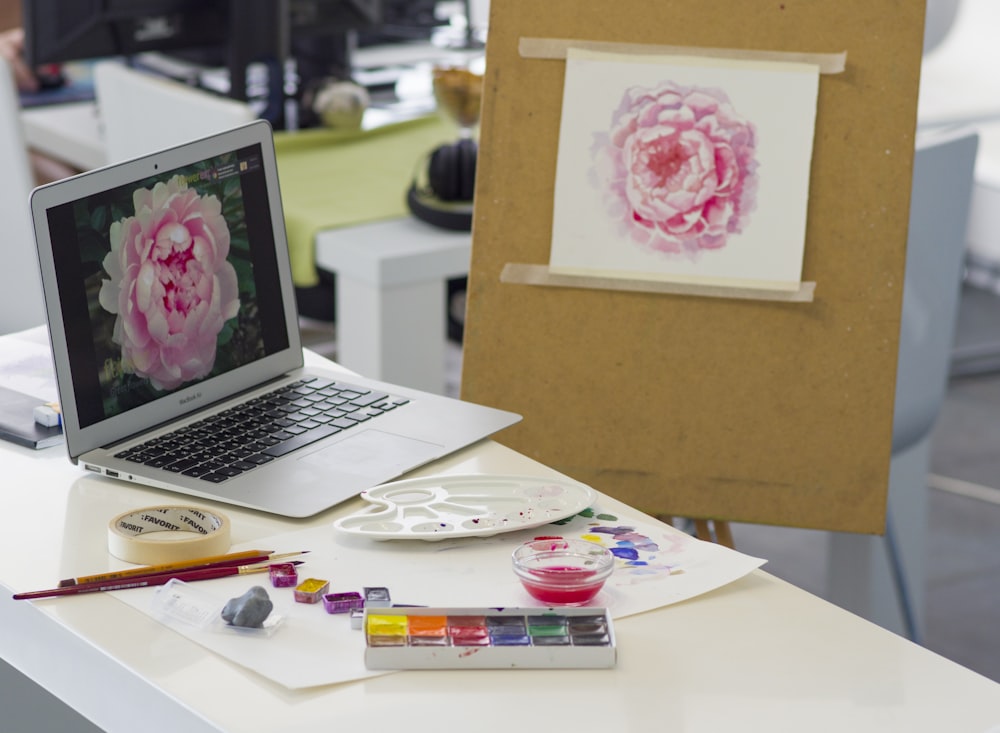- Super Glue vs Epoxy - February 10, 2022
- How to Get Started with Stippling Art - January 18, 2022
- Brother PE770 Review and Guide - January 14, 2022
You may be planning your next painting project, or perhaps painting has become a new hobby over lockdown? Either way, it’s a relaxing activity and a rewarding experience. And part of the creative process is understanding which paints are most suitable for your project.
It may be that you’ve always worked with one particular kind of paint, and it’s easy to get attached to the familiar, or a fellow creative friend uses one type of paint, and so you’re leaning towards his or her preference.
However, keen artists and crafters know there’s a wide choice of paints out there to choose from. So, today, we’re looking at two popular mediums: Gouache vs Watercolor.
Main Differences Between Gouache vs Watercolor
The main differences between Gouache vs Watercolor are:
- Gouache pigments are larger and have more body, whereas watercolor pigments are smaller and this is why the color looks more translucent when dry.
- Gouache paint doesn’t make the paper show, whereas with watercolor the paper can curl.
What’s Gouache?
Not as well known as watercolor or acrylic paint, yet it’s been around for seven centuries. It was initially known as a term rather than a type of paint (more on this below!) In short, Gouache is more opaque than watercolor paint. When you use Gouache on paper, the paper doesn’t show through as much as watercolors do. Also, Gouache boasts a matte finish.
Gouache paint has three chief ingredients: binder, additives, and pigment. We’ve said that it’s opaque, but it becomes translucent if you add water to it. You can use Gouache either on its own or water it down. Either way, the finished result will look bright, radiant, and matte.
Other than the characteristics we’ve already mentioned, Gouache dries quickly, but the colors you see when the paint dries look slightly different from when it’s applied wet.
What’s Watercolor?
Most of us have used watercolor paint at some point in our lives without even necessarily knowing it. Think of all the paintings you brought home from school or projects you had to do in art class. You’ll likely have used watercolor paints or bought them with your allowance when you were a kid without thinking about what they really are.
Watercolors are precisely what they say on the tin. They’re water-based paints, that when applied to white paper, you can still see what’s underneath. For example, preliminary sketches and so on. This is because watercolor is transparent, which means light can travel through the colors and reflect off the white paper you’re painting on, giving watercolors a more luminous look.
Just like Gouache, they’ve been around almost forever. Historically, you can trace them back to the ancient Egyptians, cave paintings, and ancient Asian civilizations. Traditional Chinese paintings were created with watercolor paints around 4,000 B.C., and by the 4th century, watercolors were used in Asia for landscape paintings.
So far, so good, but:
Tell Me More About Gouache Paint?
Since it’s a type of paint that dries pretty quickly, it’s popular with illustrators and commercial artists when creating posters, murals, comics, and other kinds of design work. Perhaps most famously, it was used by late 19th and early 20th century artists, including Russian-French artist Marc Chagall, French artists Henri Matisse and Edgar Degas, and Spanish artists Salvador Dali and Pablo Picasso.
However, like watercolors (see below), it’s been around for a lot longer. Initially, it was known more as a term than a type of paint. While it was first introduced in the 18th century (as we know it), it’s been used by artists for centuries, with Persian artists using a basic form to create famous miniature paintings.
That said, it’s not simply reserved for the professionals. It’s a popular paint for amateur artists and keen crafters alike. What’s great is that you can use Gouache on paper and plywood, silk, and cardboard.
It’s possible to work with this type of paint on watercolor paper and layer it. Just wait for the first layer to dry before applying the next. If not, the colors will bleed into one another, and you’ll have a bit of a mess on your hands! Although layering is a great technique, too much layering will cause the entire bottom layer just to lift off the paper, so proceed with caution.
Tell Me More About Watercolor?
Like Gouache, watercolor paints are used by amateurs and professionals alike. Artists who made the medium famous include German printmaker and painter Albrecht Dürer, English poet William Blake, English artists JMW Turner and John Constable, Dutch artist Vincent van Gogh and American painter Edward Hopper.
It’s a great medium to work with as a beginner because watercolor paints are pretty low maintenance and come in different grades, depending on your experience. You can buy watercolor paints across children’s, student, and artist grades. If you’re just starting out, try the student grade paints before investing in pro artist sets.
Using Gouache For the First Time
If you like the idea of using Gouache because you’re seduced by the idea of vibrant and easy-to-apply colors, then you’re not alone. However, before going all out and investing in tons of Gouache paints, here’s what you’re going to need before starting out:
- Your Gouache paint: There are lots of Gouache paint brands available. These come in tubes, as just a quick look online will tell you. We think your best bet is starting with a few primary colors (blue, red, yellow), some secondary colors (green, orange, violet), and some tubes of black and white to make it easier for you to mix your paints. There are Gouache paint sets available for beginners, which may be a good starting point before investing further.
- Your Gouache paintbrushes: You’ll see below that we’ve gone into lots of detail about watercolor paintbrushes. Here, we’re just going to say that Gouache paintbrushes are pretty much the same as watercolor ones. The main thing to remember is that some brushes are super expensive, and you may not want to spend lots of money if you’re just starting out. So, set yourself a budget and stick to it. Don’t feel pressured into buying the best of the best if you’re just dabbling in Gouache for the first time.
- Your paper or other surfaces you want to paint: You can use watercolor paper when using Gouache paint, but if you’re an illustrator, good-quality, thick drawing paper works too. If you’re wondering about canvas, we advise giving that a swerve. It’s way better suited to acrylic paints instead.
- Your mixing tray: As Gouache paint comes in tubes, you’re going to need something to mix them in. If you’re new to mixing, start small. Pop a little bit of one color on your tray, and then simply add another color or water to achieve the shade you’re aiming for.
- Water: You’ll need water to mix your paints and to keep your brushes wet. This makes it easier to get the color on the surface, and of course, to clean your brushes when you’re done.
Using Watercolor For the First Time
Before heading on down to your nearest art supply store or your favorite online art retailer, it’s worth familiarizing yourself with precisely what you need before embarking on your watercolor journey.
The basic materials you need include:
- A watercolor palette: Ideally, this will be just one palette boasting a good range of colors, rather than multiple palettes. With a decent range of colors to hand, you won’t have to mix your own colors so much, although this may be something you want to experiment with more as your technique progresses.
- Your paintbrushes: It’s an excellent idea to start with a broad selection of brush sizes and types so that you can try different techniques. The most versatile brushes are round and flat across various sizes, while spotter and rigger brushes are better for painting finer details. You’ll also need wash brushes.You’ll see pretty quickly that brush prices vary wildly. The best ones are made out of sable because they hold a fair amount of water and paint, and they’re resilient. These brushes usually withstand the test of time. However, sable brushes can be super expensive, so if you’re an absolute beginner, we advise checking out online reviews before parting with your hard-earned cash. It’s possible you may want to start with cheaper brushes made out of synthetic fibers, but be aware, typically, they’re not as long-lasting.
- Your paper: The aim is to use paper that doesn’t absorb your paint pigments. That’s why purchasing a proper watercolor paper is your best bet. This allows the paint to sit on top of the paper and dry. If you don’t believe us, try using watercolors on simple photocopier paper and watch as the paint bleeds to the edges.
- Water and a cloth: The water is used to hydrate your paints and to clean your brushes. The fabric, on the other hand, is so you can blot your brushes.
Gouache vs. Watercolor: Their Pros and Cons
By now, you may have a clearer idea of which paint is best for you, or you might be considering using both in your artwork. Either way, here’s a quick roundup of the pros and cons of each:
The Pros:
- Both are inexpensive to buy
- Gouache is easy to use on different materials.
- Beginner’s paint sets for both Gouache and watercolors are pretty cheap.
- It’s easy to correct your mistakes with either type of paint.
- Gouache uses less water, and the colors don’t bleed together when they touch.
- Watercolors have a lovely translucent finish.
- Watercolors are easy to blend.
- You can paint darker Gouache colors onto lighter ones.
The Cons:
- Watercolor is suitable for particular kinds of paper only.
- Watercolor takes longer to dry.
- High-quality watercolor and Gouache brushes can be expensive.
- If you want your colors to bleed together, this effect is harder to achieve with Gouache.
- You have to paint light watercolors onto dark watercolors. You can’t do the reverse.
FAQs
Question: How much water should I use when mixing?
Answer: It may sound easy, but in reality, mixing your paints is an art in itself and one you’ll perfect over time as you become more experienced.
Where Gouache is concerned, it’s important to remember not to add too much water. On the flip side, it’s equally important not to use too little; otherwise, the paint will crack. Ideally, you’re aiming for the same consistency as cream so that your paint glides smoothly from brush to paper.
But, where watercolors are concerned, you can use more water, but the amount will depend on the depth of color you want to achieve. More faded colors require more water, whereas a more robust, bolder look needs less. Try playing around a little at first to see the effects you can achieve before committing the results to paper.
Question: Can you correct errors with these paints?
Answer: Quick answer: yes, you can. We all make mistakes when painting, and it’s good news you can correct your painting errors/change of tack.
As both paints are soluble, it’s possible to lift off areas of the painting with a damp brush and rework your painting.
Question: Can I use the two together?
Answer: Again, quick answer: yes, you can. You can also use both paints on their own or with acrylic paints too. Gouache is also suitable for abstract work, marbling, calligraphy, and fine detail.
If you want to work with both paints in the same painting, your best bet is starting with watercolors first as a base and background (on top of your sketch), and then add Gouache after for greater definition, depth, and bolder colors.
Question: Are Gouache and acrylic the same thing?
Answer: No, they’re not. Acrylic is waterproof and can be used on more surfaces than Gouache can. Gouache can be applied in layers, but nowhere near like the thick layers, you can create with acrylic paint.
It’s also possible to use other tools when painting with acrylics, such as palette knives, whereas Gouache is best used with just brushes. You also can’t re-wet acrylic paint, whereas you already know that Gouache can be re-wet, and it’s easier to make changes. You can indeed paint over acrylic when it’s dry, but you can’t reactivate the paint with water as you can with Gouache.
Question: How do I protect my Gouache or watercolor paintings?
Answer: Since both types of paints are impacted by water, once they’re dry and complete, the best way to protect both is with filtered glass or an acrylic screen.
In the case of watercolors, because the colors are so fragile and responsive to light, they are in danger of fading, so keep them out of direct sunlight. Ideally, the watercolor should be mounted on an acid-free board to keep the watercolor paper from discoloring.
The same applies to Gouache paintings as far as water is concerned and glass and/or acrylic screens. You can also add an extra layer of protection by spraying them with a spray fixative, which you can buy from any reputable art supplier.
Gouache vs Watercolor: Which Will You Opt For?
Hopefully, after reading this, you’re ready to start experimenting with either Gouache, watercolor, or both if you’re feeling ambitious! We have no personal preference. It all depends on what effect you’re trying to achieve. Both types of paint are fun to use and experiment with, and when used well, empower you to attain near-on endless artistic possibilities.
Good luck, and let us know how you get on in the comment box below!
To get more craft inspiration, check this material guides:






